Accounting Theory and Issues Report: Boral Limited Financial Analysis
VerifiedAdded on 2023/05/30
|12
|2406
|291
Report
AI Summary
This report delves into the conceptual framework of general purpose financial reporting (GPFR) and its application, using Boral Limited's 2018 financial report as a case study. The report explores the objectives of GPFR, including providing useful information for decision-making, predicting cash flows, and understanding economic resources and claims. It examines the elements of financial statements (assets, liabilities, equity, revenues, and expenses), along with recognition and measurement principles and assumptions. The report also analyzes the qualitative characteristics of financial information, differentiating between primary characteristics (relevance, reliability, and materiality) and secondary characteristics (comparability and consistency). The conclusion emphasizes Boral Limited's compliance with GPFR requirements, highlighting the reliability of the financial information for user decision-making and the consistent application of recognition criteria. The report provides a thorough overview of accounting theory and its practical application in financial reporting.
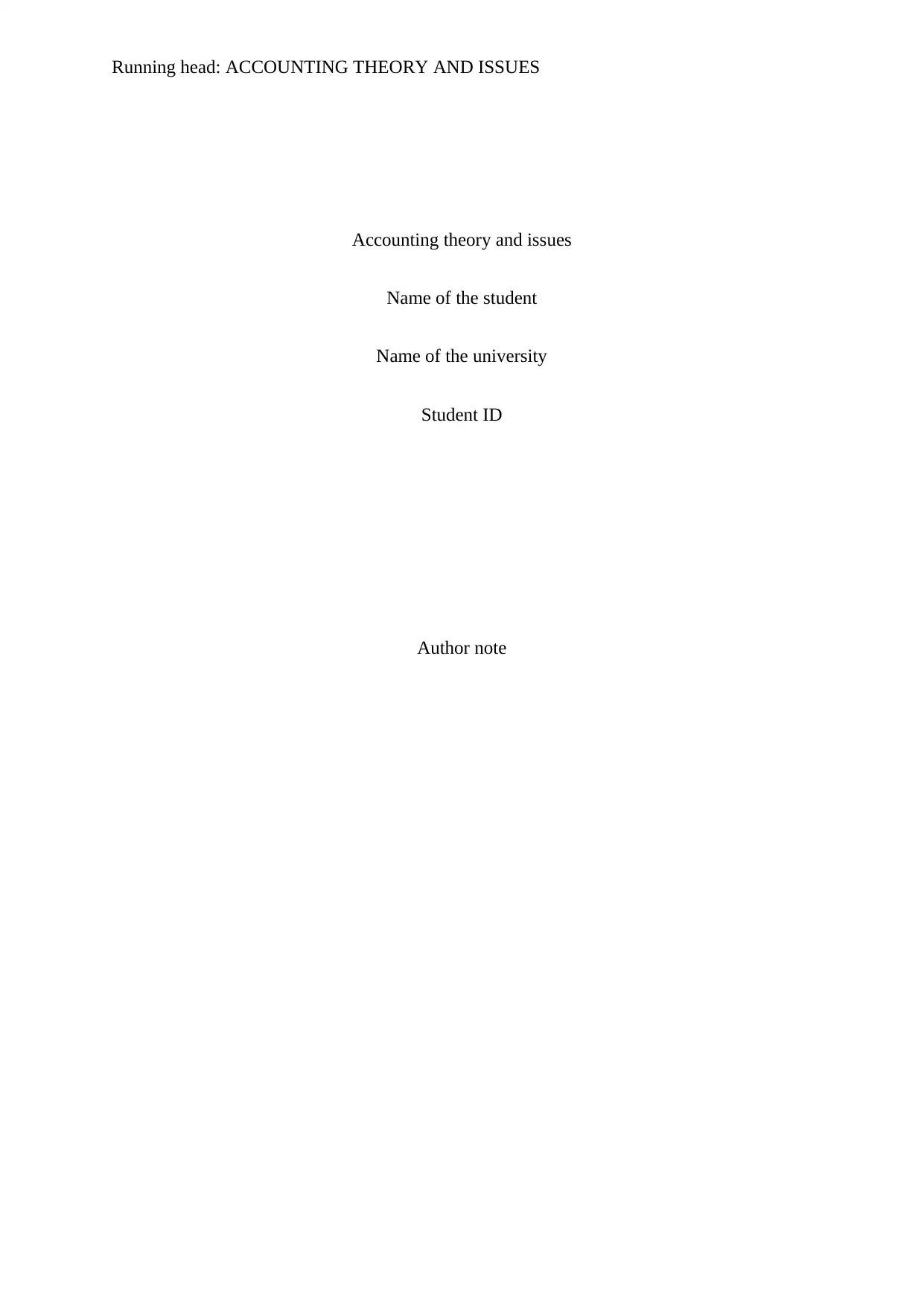
Running head: ACCOUNTING THEORY AND ISSUES
Accounting theory and issues
Name of the student
Name of the university
Student ID
Author note
Accounting theory and issues
Name of the student
Name of the university
Student ID
Author note
Paraphrase This Document
Need a fresh take? Get an instant paraphrase of this document with our AI Paraphraser
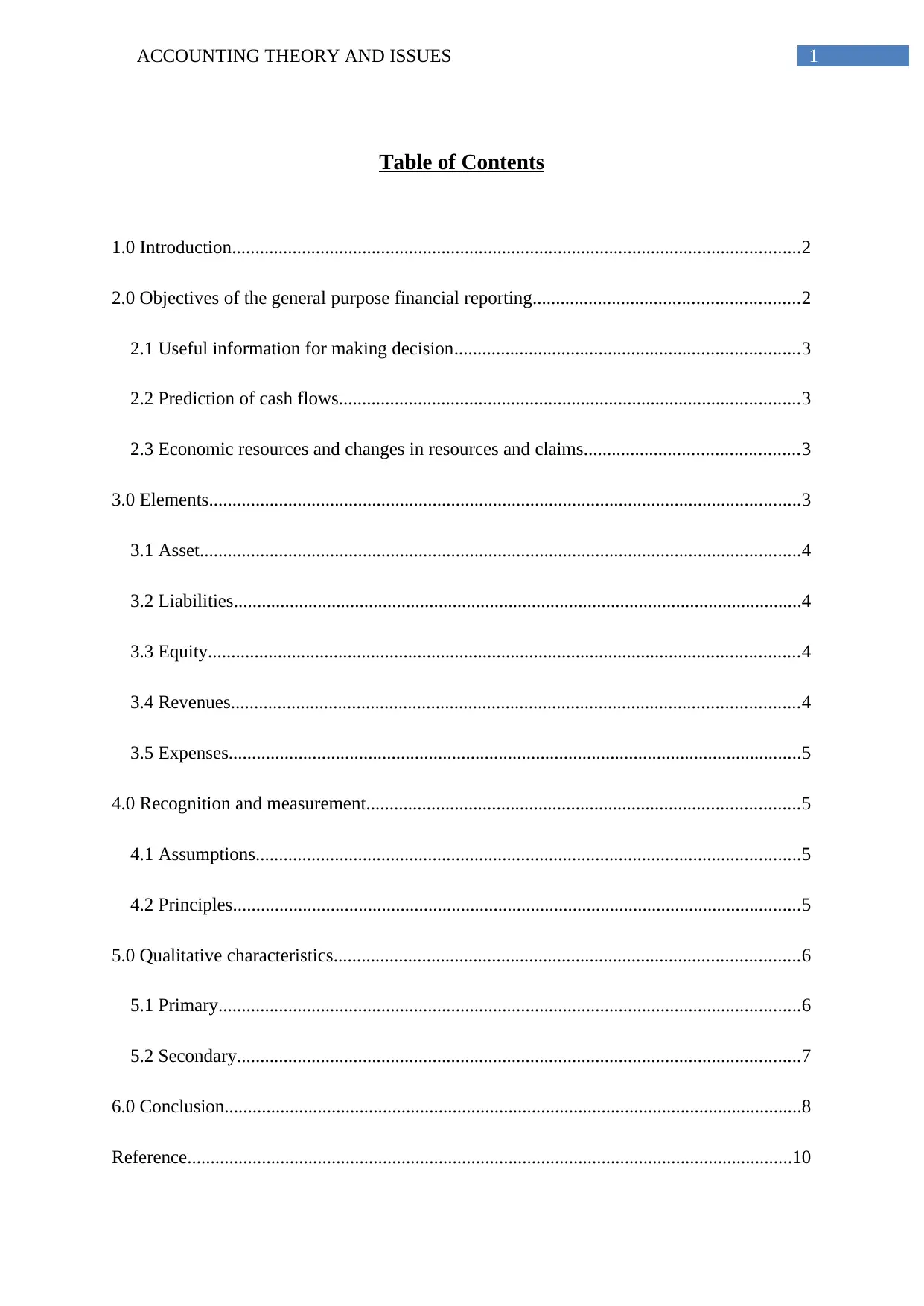
1ACCOUNTING THEORY AND ISSUES
Table of Contents
1.0 Introduction..........................................................................................................................2
2.0 Objectives of the general purpose financial reporting.........................................................2
2.1 Useful information for making decision..........................................................................3
2.2 Prediction of cash flows...................................................................................................3
2.3 Economic resources and changes in resources and claims..............................................3
3.0 Elements...............................................................................................................................3
3.1 Asset.................................................................................................................................4
3.2 Liabilities..........................................................................................................................4
3.3 Equity...............................................................................................................................4
3.4 Revenues..........................................................................................................................4
3.5 Expenses...........................................................................................................................5
4.0 Recognition and measurement.............................................................................................5
4.1 Assumptions.....................................................................................................................5
4.2 Principles..........................................................................................................................5
5.0 Qualitative characteristics....................................................................................................6
5.1 Primary.............................................................................................................................6
5.2 Secondary.........................................................................................................................7
6.0 Conclusion............................................................................................................................8
Reference..................................................................................................................................10
Table of Contents
1.0 Introduction..........................................................................................................................2
2.0 Objectives of the general purpose financial reporting.........................................................2
2.1 Useful information for making decision..........................................................................3
2.2 Prediction of cash flows...................................................................................................3
2.3 Economic resources and changes in resources and claims..............................................3
3.0 Elements...............................................................................................................................3
3.1 Asset.................................................................................................................................4
3.2 Liabilities..........................................................................................................................4
3.3 Equity...............................................................................................................................4
3.4 Revenues..........................................................................................................................4
3.5 Expenses...........................................................................................................................5
4.0 Recognition and measurement.............................................................................................5
4.1 Assumptions.....................................................................................................................5
4.2 Principles..........................................................................................................................5
5.0 Qualitative characteristics....................................................................................................6
5.1 Primary.............................................................................................................................6
5.2 Secondary.........................................................................................................................7
6.0 Conclusion............................................................................................................................8
Reference..................................................................................................................................10
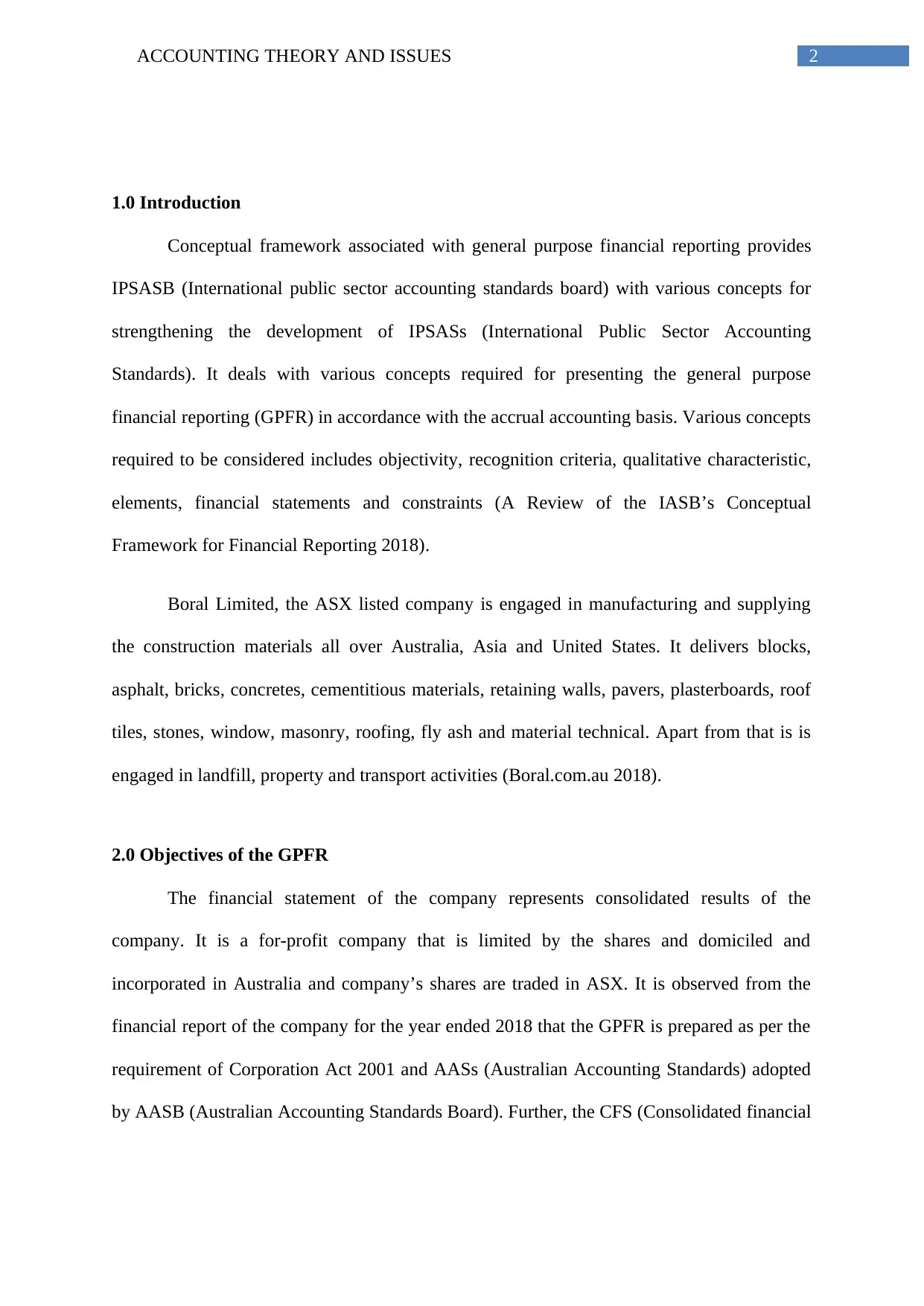
2ACCOUNTING THEORY AND ISSUES
1.0 Introduction
Conceptual framework associated with general purpose financial reporting provides
IPSASB (International public sector accounting standards board) with various concepts for
strengthening the development of IPSASs (International Public Sector Accounting
Standards). It deals with various concepts required for presenting the general purpose
financial reporting (GPFR) in accordance with the accrual accounting basis. Various concepts
required to be considered includes objectivity, recognition criteria, qualitative characteristic,
elements, financial statements and constraints (A Review of the IASB’s Conceptual
Framework for Financial Reporting 2018).
Boral Limited, the ASX listed company is engaged in manufacturing and supplying
the construction materials all over Australia, Asia and United States. It delivers blocks,
asphalt, bricks, concretes, cementitious materials, retaining walls, pavers, plasterboards, roof
tiles, stones, window, masonry, roofing, fly ash and material technical. Apart from that is is
engaged in landfill, property and transport activities (Boral.com.au 2018).
2.0 Objectives of the GPFR
The financial statement of the company represents consolidated results of the
company. It is a for-profit company that is limited by the shares and domiciled and
incorporated in Australia and company’s shares are traded in ASX. It is observed from the
financial report of the company for the year ended 2018 that the GPFR is prepared as per the
requirement of Corporation Act 2001 and AASs (Australian Accounting Standards) adopted
by AASB (Australian Accounting Standards Board). Further, the CFS (Consolidated financial
1.0 Introduction
Conceptual framework associated with general purpose financial reporting provides
IPSASB (International public sector accounting standards board) with various concepts for
strengthening the development of IPSASs (International Public Sector Accounting
Standards). It deals with various concepts required for presenting the general purpose
financial reporting (GPFR) in accordance with the accrual accounting basis. Various concepts
required to be considered includes objectivity, recognition criteria, qualitative characteristic,
elements, financial statements and constraints (A Review of the IASB’s Conceptual
Framework for Financial Reporting 2018).
Boral Limited, the ASX listed company is engaged in manufacturing and supplying
the construction materials all over Australia, Asia and United States. It delivers blocks,
asphalt, bricks, concretes, cementitious materials, retaining walls, pavers, plasterboards, roof
tiles, stones, window, masonry, roofing, fly ash and material technical. Apart from that is is
engaged in landfill, property and transport activities (Boral.com.au 2018).
2.0 Objectives of the GPFR
The financial statement of the company represents consolidated results of the
company. It is a for-profit company that is limited by the shares and domiciled and
incorporated in Australia and company’s shares are traded in ASX. It is observed from the
financial report of the company for the year ended 2018 that the GPFR is prepared as per the
requirement of Corporation Act 2001 and AASs (Australian Accounting Standards) adopted
by AASB (Australian Accounting Standards Board). Further, the CFS (Consolidated financial
⊘ This is a preview!⊘
Do you want full access?
Subscribe today to unlock all pages.

Trusted by 1+ million students worldwide
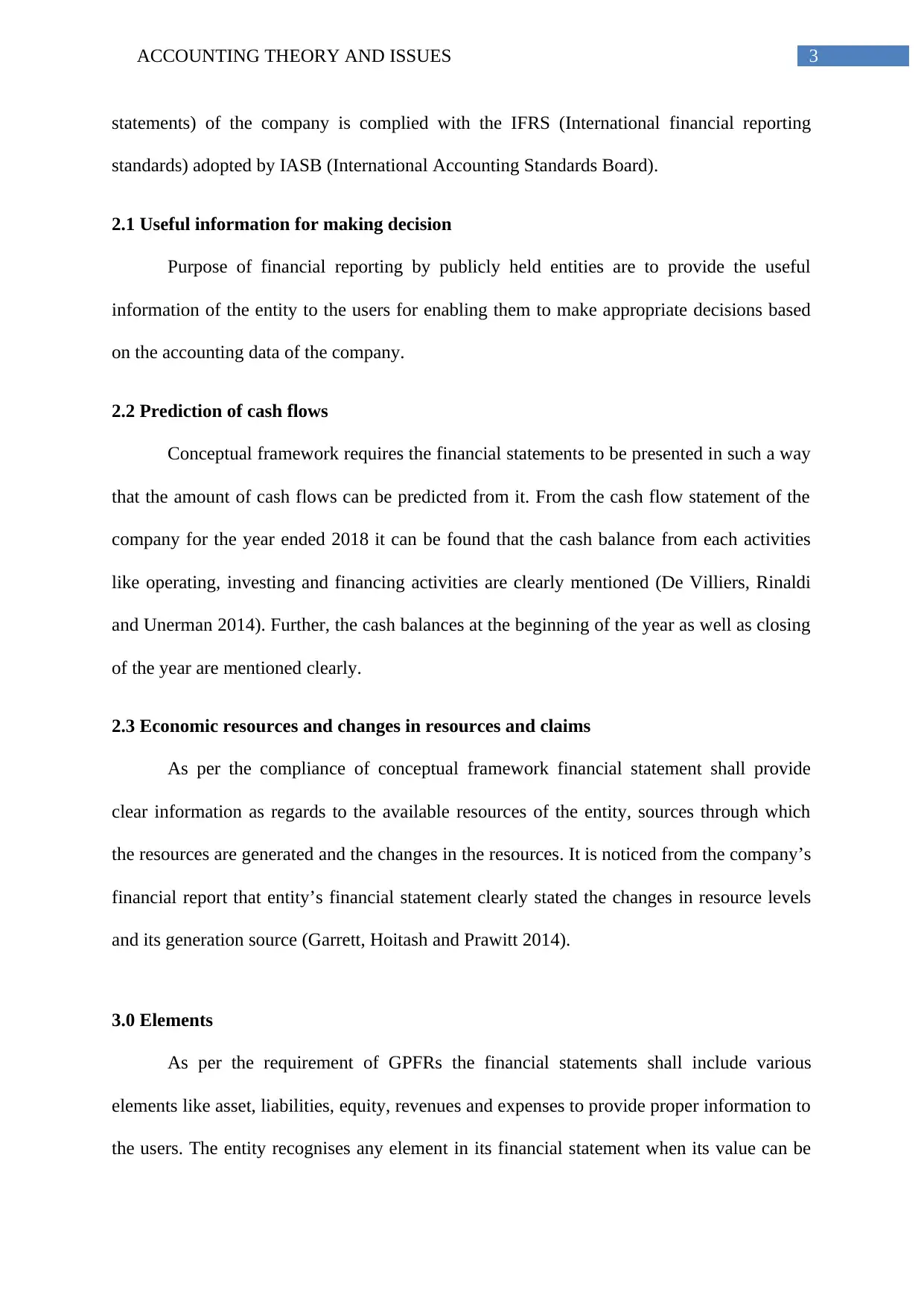
3ACCOUNTING THEORY AND ISSUES
statements) of the company is complied with the IFRS (International financial reporting
standards) adopted by IASB (International Accounting Standards Board).
2.1 Useful information for making decision
Purpose of financial reporting by publicly held entities are to provide the useful
information of the entity to the users for enabling them to make appropriate decisions based
on the accounting data of the company.
2.2 Prediction of cash flows
Conceptual framework requires the financial statements to be presented in such a way
that the amount of cash flows can be predicted from it. From the cash flow statement of the
company for the year ended 2018 it can be found that the cash balance from each activities
like operating, investing and financing activities are clearly mentioned (De Villiers, Rinaldi
and Unerman 2014). Further, the cash balances at the beginning of the year as well as closing
of the year are mentioned clearly.
2.3 Economic resources and changes in resources and claims
As per the compliance of conceptual framework financial statement shall provide
clear information as regards to the available resources of the entity, sources through which
the resources are generated and the changes in the resources. It is noticed from the company’s
financial report that entity’s financial statement clearly stated the changes in resource levels
and its generation source (Garrett, Hoitash and Prawitt 2014).
3.0 Elements
As per the requirement of GPFRs the financial statements shall include various
elements like asset, liabilities, equity, revenues and expenses to provide proper information to
the users. The entity recognises any element in its financial statement when its value can be
statements) of the company is complied with the IFRS (International financial reporting
standards) adopted by IASB (International Accounting Standards Board).
2.1 Useful information for making decision
Purpose of financial reporting by publicly held entities are to provide the useful
information of the entity to the users for enabling them to make appropriate decisions based
on the accounting data of the company.
2.2 Prediction of cash flows
Conceptual framework requires the financial statements to be presented in such a way
that the amount of cash flows can be predicted from it. From the cash flow statement of the
company for the year ended 2018 it can be found that the cash balance from each activities
like operating, investing and financing activities are clearly mentioned (De Villiers, Rinaldi
and Unerman 2014). Further, the cash balances at the beginning of the year as well as closing
of the year are mentioned clearly.
2.3 Economic resources and changes in resources and claims
As per the compliance of conceptual framework financial statement shall provide
clear information as regards to the available resources of the entity, sources through which
the resources are generated and the changes in the resources. It is noticed from the company’s
financial report that entity’s financial statement clearly stated the changes in resource levels
and its generation source (Garrett, Hoitash and Prawitt 2014).
3.0 Elements
As per the requirement of GPFRs the financial statements shall include various
elements like asset, liabilities, equity, revenues and expenses to provide proper information to
the users. The entity recognises any element in its financial statement when its value can be
Paraphrase This Document
Need a fresh take? Get an instant paraphrase of this document with our AI Paraphraser
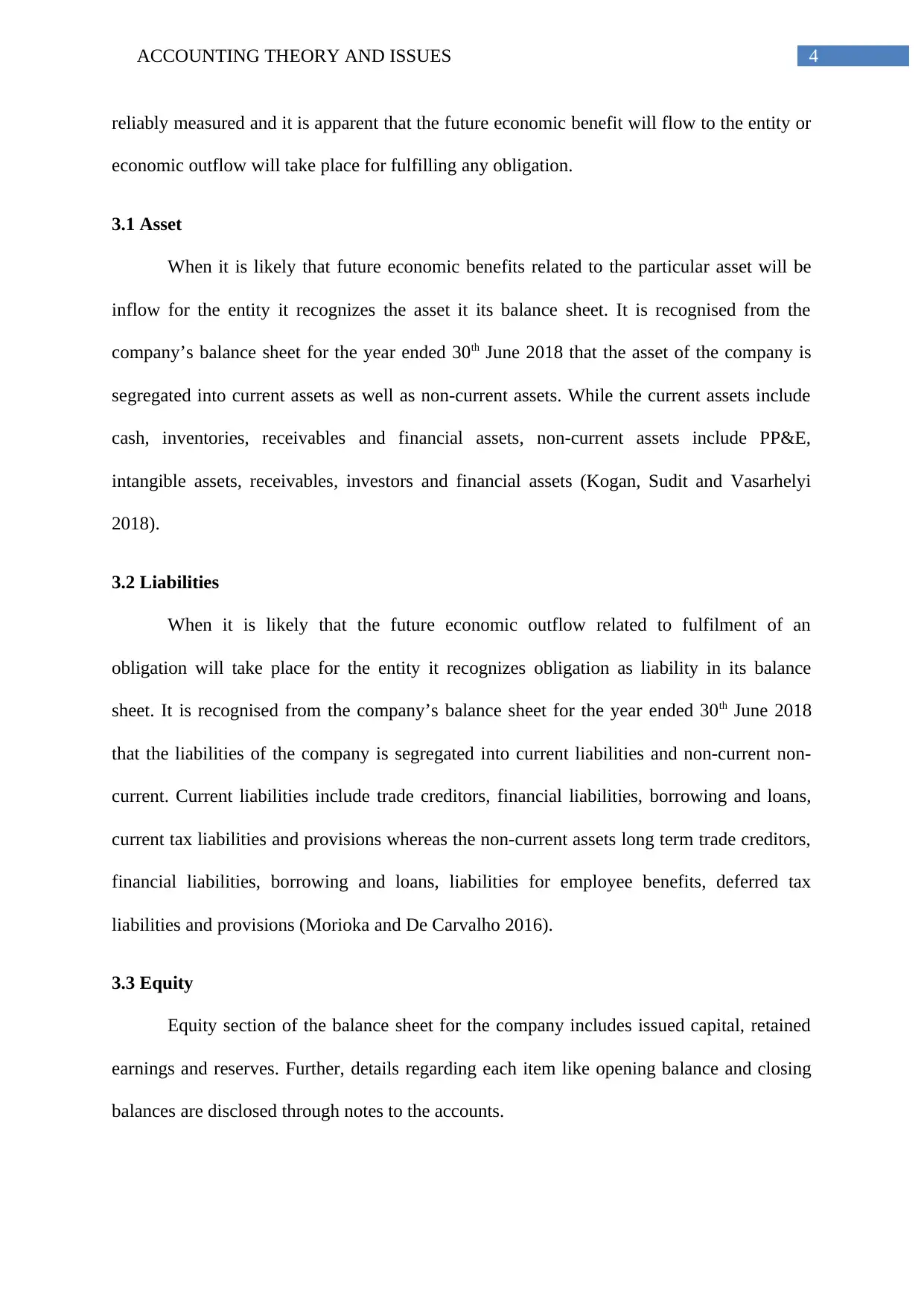
4ACCOUNTING THEORY AND ISSUES
reliably measured and it is apparent that the future economic benefit will flow to the entity or
economic outflow will take place for fulfilling any obligation.
3.1 Asset
When it is likely that future economic benefits related to the particular asset will be
inflow for the entity it recognizes the asset it its balance sheet. It is recognised from the
company’s balance sheet for the year ended 30th June 2018 that the asset of the company is
segregated into current assets as well as non-current assets. While the current assets include
cash, inventories, receivables and financial assets, non-current assets include PP&E,
intangible assets, receivables, investors and financial assets (Kogan, Sudit and Vasarhelyi
2018).
3.2 Liabilities
When it is likely that the future economic outflow related to fulfilment of an
obligation will take place for the entity it recognizes obligation as liability in its balance
sheet. It is recognised from the company’s balance sheet for the year ended 30th June 2018
that the liabilities of the company is segregated into current liabilities and non-current non-
current. Current liabilities include trade creditors, financial liabilities, borrowing and loans,
current tax liabilities and provisions whereas the non-current assets long term trade creditors,
financial liabilities, borrowing and loans, liabilities for employee benefits, deferred tax
liabilities and provisions (Morioka and De Carvalho 2016).
3.3 Equity
Equity section of the balance sheet for the company includes issued capital, retained
earnings and reserves. Further, details regarding each item like opening balance and closing
balances are disclosed through notes to the accounts.
reliably measured and it is apparent that the future economic benefit will flow to the entity or
economic outflow will take place for fulfilling any obligation.
3.1 Asset
When it is likely that future economic benefits related to the particular asset will be
inflow for the entity it recognizes the asset it its balance sheet. It is recognised from the
company’s balance sheet for the year ended 30th June 2018 that the asset of the company is
segregated into current assets as well as non-current assets. While the current assets include
cash, inventories, receivables and financial assets, non-current assets include PP&E,
intangible assets, receivables, investors and financial assets (Kogan, Sudit and Vasarhelyi
2018).
3.2 Liabilities
When it is likely that the future economic outflow related to fulfilment of an
obligation will take place for the entity it recognizes obligation as liability in its balance
sheet. It is recognised from the company’s balance sheet for the year ended 30th June 2018
that the liabilities of the company is segregated into current liabilities and non-current non-
current. Current liabilities include trade creditors, financial liabilities, borrowing and loans,
current tax liabilities and provisions whereas the non-current assets long term trade creditors,
financial liabilities, borrowing and loans, liabilities for employee benefits, deferred tax
liabilities and provisions (Morioka and De Carvalho 2016).
3.3 Equity
Equity section of the balance sheet for the company includes issued capital, retained
earnings and reserves. Further, details regarding each item like opening balance and closing
balances are disclosed through notes to the accounts.
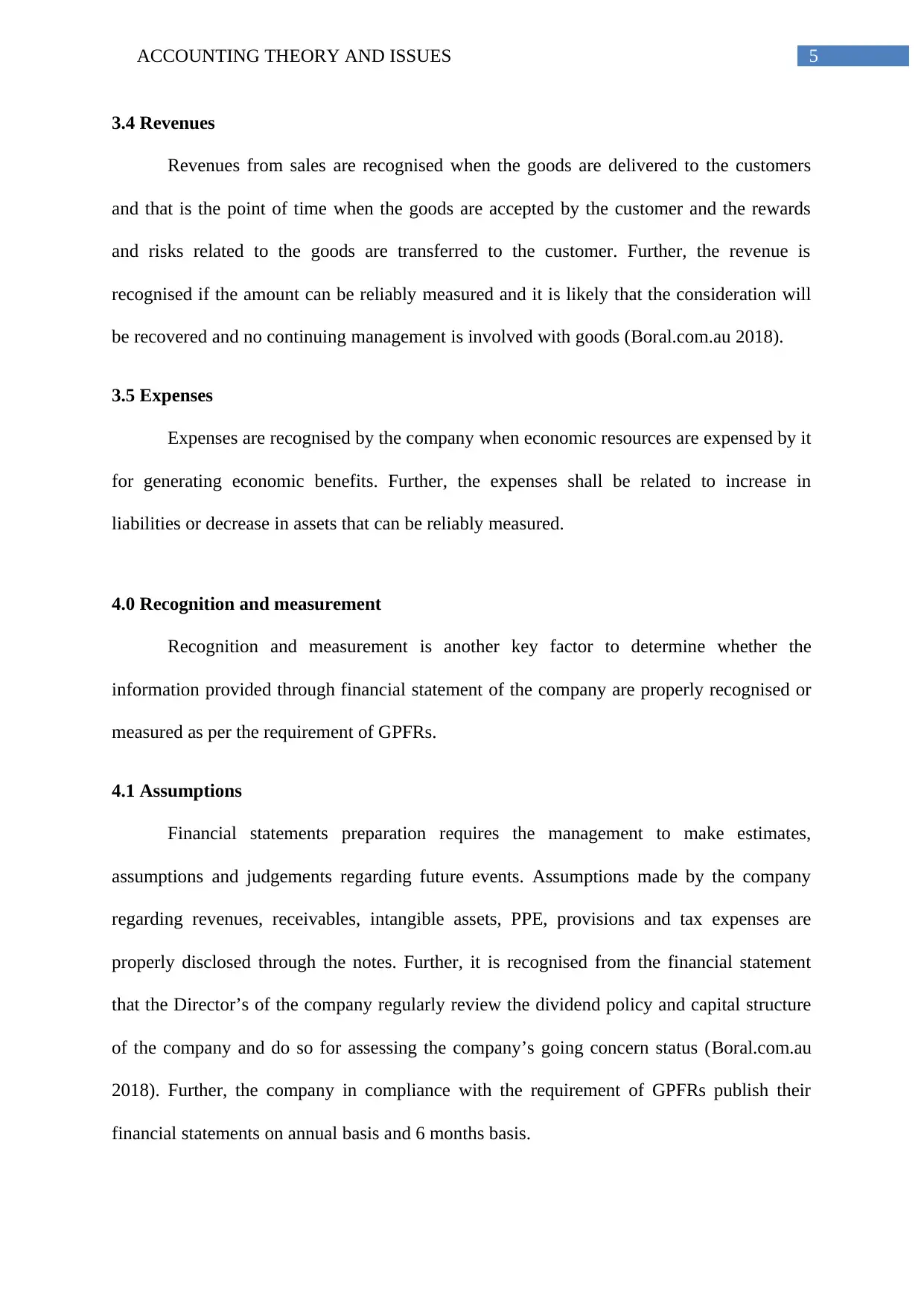
5ACCOUNTING THEORY AND ISSUES
3.4 Revenues
Revenues from sales are recognised when the goods are delivered to the customers
and that is the point of time when the goods are accepted by the customer and the rewards
and risks related to the goods are transferred to the customer. Further, the revenue is
recognised if the amount can be reliably measured and it is likely that the consideration will
be recovered and no continuing management is involved with goods (Boral.com.au 2018).
3.5 Expenses
Expenses are recognised by the company when economic resources are expensed by it
for generating economic benefits. Further, the expenses shall be related to increase in
liabilities or decrease in assets that can be reliably measured.
4.0 Recognition and measurement
Recognition and measurement is another key factor to determine whether the
information provided through financial statement of the company are properly recognised or
measured as per the requirement of GPFRs.
4.1 Assumptions
Financial statements preparation requires the management to make estimates,
assumptions and judgements regarding future events. Assumptions made by the company
regarding revenues, receivables, intangible assets, PPE, provisions and tax expenses are
properly disclosed through the notes. Further, it is recognised from the financial statement
that the Director’s of the company regularly review the dividend policy and capital structure
of the company and do so for assessing the company’s going concern status (Boral.com.au
2018). Further, the company in compliance with the requirement of GPFRs publish their
financial statements on annual basis and 6 months basis.
3.4 Revenues
Revenues from sales are recognised when the goods are delivered to the customers
and that is the point of time when the goods are accepted by the customer and the rewards
and risks related to the goods are transferred to the customer. Further, the revenue is
recognised if the amount can be reliably measured and it is likely that the consideration will
be recovered and no continuing management is involved with goods (Boral.com.au 2018).
3.5 Expenses
Expenses are recognised by the company when economic resources are expensed by it
for generating economic benefits. Further, the expenses shall be related to increase in
liabilities or decrease in assets that can be reliably measured.
4.0 Recognition and measurement
Recognition and measurement is another key factor to determine whether the
information provided through financial statement of the company are properly recognised or
measured as per the requirement of GPFRs.
4.1 Assumptions
Financial statements preparation requires the management to make estimates,
assumptions and judgements regarding future events. Assumptions made by the company
regarding revenues, receivables, intangible assets, PPE, provisions and tax expenses are
properly disclosed through the notes. Further, it is recognised from the financial statement
that the Director’s of the company regularly review the dividend policy and capital structure
of the company and do so for assessing the company’s going concern status (Boral.com.au
2018). Further, the company in compliance with the requirement of GPFRs publish their
financial statements on annual basis and 6 months basis.
⊘ This is a preview!⊘
Do you want full access?
Subscribe today to unlock all pages.

Trusted by 1+ million students worldwide
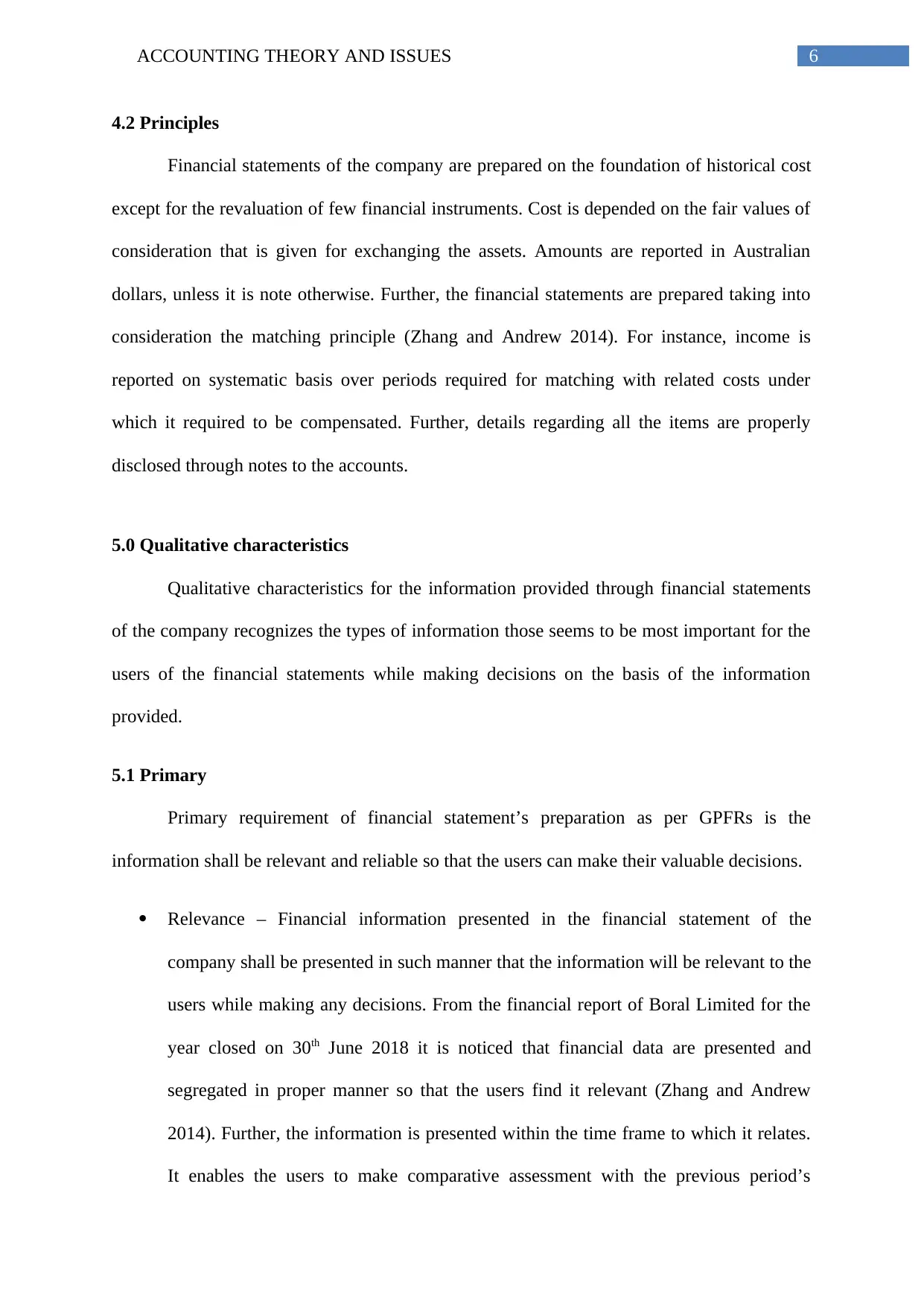
6ACCOUNTING THEORY AND ISSUES
4.2 Principles
Financial statements of the company are prepared on the foundation of historical cost
except for the revaluation of few financial instruments. Cost is depended on the fair values of
consideration that is given for exchanging the assets. Amounts are reported in Australian
dollars, unless it is note otherwise. Further, the financial statements are prepared taking into
consideration the matching principle (Zhang and Andrew 2014). For instance, income is
reported on systematic basis over periods required for matching with related costs under
which it required to be compensated. Further, details regarding all the items are properly
disclosed through notes to the accounts.
5.0 Qualitative characteristics
Qualitative characteristics for the information provided through financial statements
of the company recognizes the types of information those seems to be most important for the
users of the financial statements while making decisions on the basis of the information
provided.
5.1 Primary
Primary requirement of financial statement’s preparation as per GPFRs is the
information shall be relevant and reliable so that the users can make their valuable decisions.
Relevance – Financial information presented in the financial statement of the
company shall be presented in such manner that the information will be relevant to the
users while making any decisions. From the financial report of Boral Limited for the
year closed on 30th June 2018 it is noticed that financial data are presented and
segregated in proper manner so that the users find it relevant (Zhang and Andrew
2014). Further, the information is presented within the time frame to which it relates.
It enables the users to make comparative assessment with the previous period’s
4.2 Principles
Financial statements of the company are prepared on the foundation of historical cost
except for the revaluation of few financial instruments. Cost is depended on the fair values of
consideration that is given for exchanging the assets. Amounts are reported in Australian
dollars, unless it is note otherwise. Further, the financial statements are prepared taking into
consideration the matching principle (Zhang and Andrew 2014). For instance, income is
reported on systematic basis over periods required for matching with related costs under
which it required to be compensated. Further, details regarding all the items are properly
disclosed through notes to the accounts.
5.0 Qualitative characteristics
Qualitative characteristics for the information provided through financial statements
of the company recognizes the types of information those seems to be most important for the
users of the financial statements while making decisions on the basis of the information
provided.
5.1 Primary
Primary requirement of financial statement’s preparation as per GPFRs is the
information shall be relevant and reliable so that the users can make their valuable decisions.
Relevance – Financial information presented in the financial statement of the
company shall be presented in such manner that the information will be relevant to the
users while making any decisions. From the financial report of Boral Limited for the
year closed on 30th June 2018 it is noticed that financial data are presented and
segregated in proper manner so that the users find it relevant (Zhang and Andrew
2014). Further, the information is presented within the time frame to which it relates.
It enables the users to make comparative assessment with the previous period’s
Paraphrase This Document
Need a fresh take? Get an instant paraphrase of this document with our AI Paraphraser
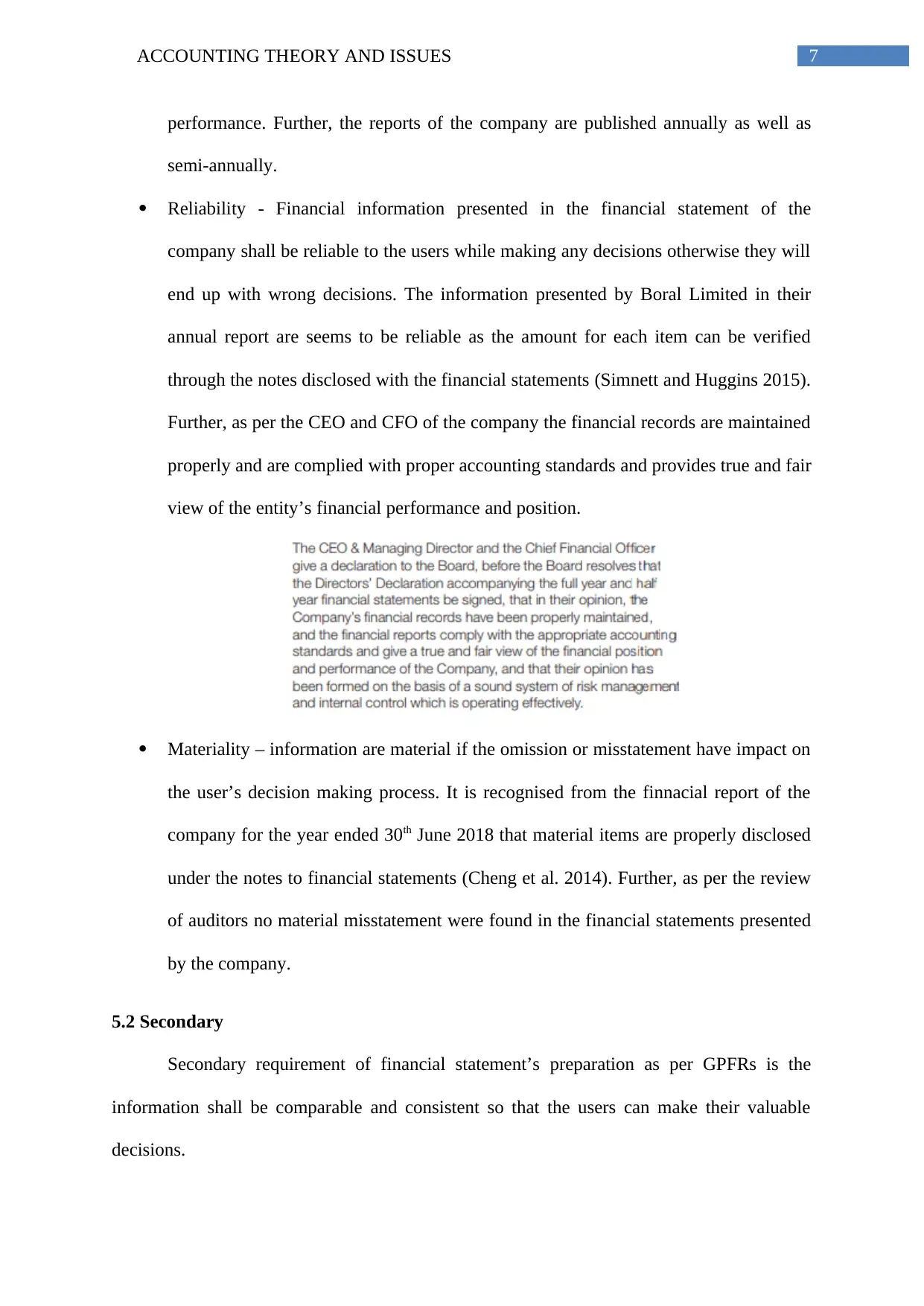
7ACCOUNTING THEORY AND ISSUES
performance. Further, the reports of the company are published annually as well as
semi-annually.
Reliability - Financial information presented in the financial statement of the
company shall be reliable to the users while making any decisions otherwise they will
end up with wrong decisions. The information presented by Boral Limited in their
annual report are seems to be reliable as the amount for each item can be verified
through the notes disclosed with the financial statements (Simnett and Huggins 2015).
Further, as per the CEO and CFO of the company the financial records are maintained
properly and are complied with proper accounting standards and provides true and fair
view of the entity’s financial performance and position.
Materiality – information are material if the omission or misstatement have impact on
the user’s decision making process. It is recognised from the finnacial report of the
company for the year ended 30th June 2018 that material items are properly disclosed
under the notes to financial statements (Cheng et al. 2014). Further, as per the review
of auditors no material misstatement were found in the financial statements presented
by the company.
5.2 Secondary
Secondary requirement of financial statement’s preparation as per GPFRs is the
information shall be comparable and consistent so that the users can make their valuable
decisions.
performance. Further, the reports of the company are published annually as well as
semi-annually.
Reliability - Financial information presented in the financial statement of the
company shall be reliable to the users while making any decisions otherwise they will
end up with wrong decisions. The information presented by Boral Limited in their
annual report are seems to be reliable as the amount for each item can be verified
through the notes disclosed with the financial statements (Simnett and Huggins 2015).
Further, as per the CEO and CFO of the company the financial records are maintained
properly and are complied with proper accounting standards and provides true and fair
view of the entity’s financial performance and position.
Materiality – information are material if the omission or misstatement have impact on
the user’s decision making process. It is recognised from the finnacial report of the
company for the year ended 30th June 2018 that material items are properly disclosed
under the notes to financial statements (Cheng et al. 2014). Further, as per the review
of auditors no material misstatement were found in the financial statements presented
by the company.
5.2 Secondary
Secondary requirement of financial statement’s preparation as per GPFRs is the
information shall be comparable and consistent so that the users can make their valuable
decisions.
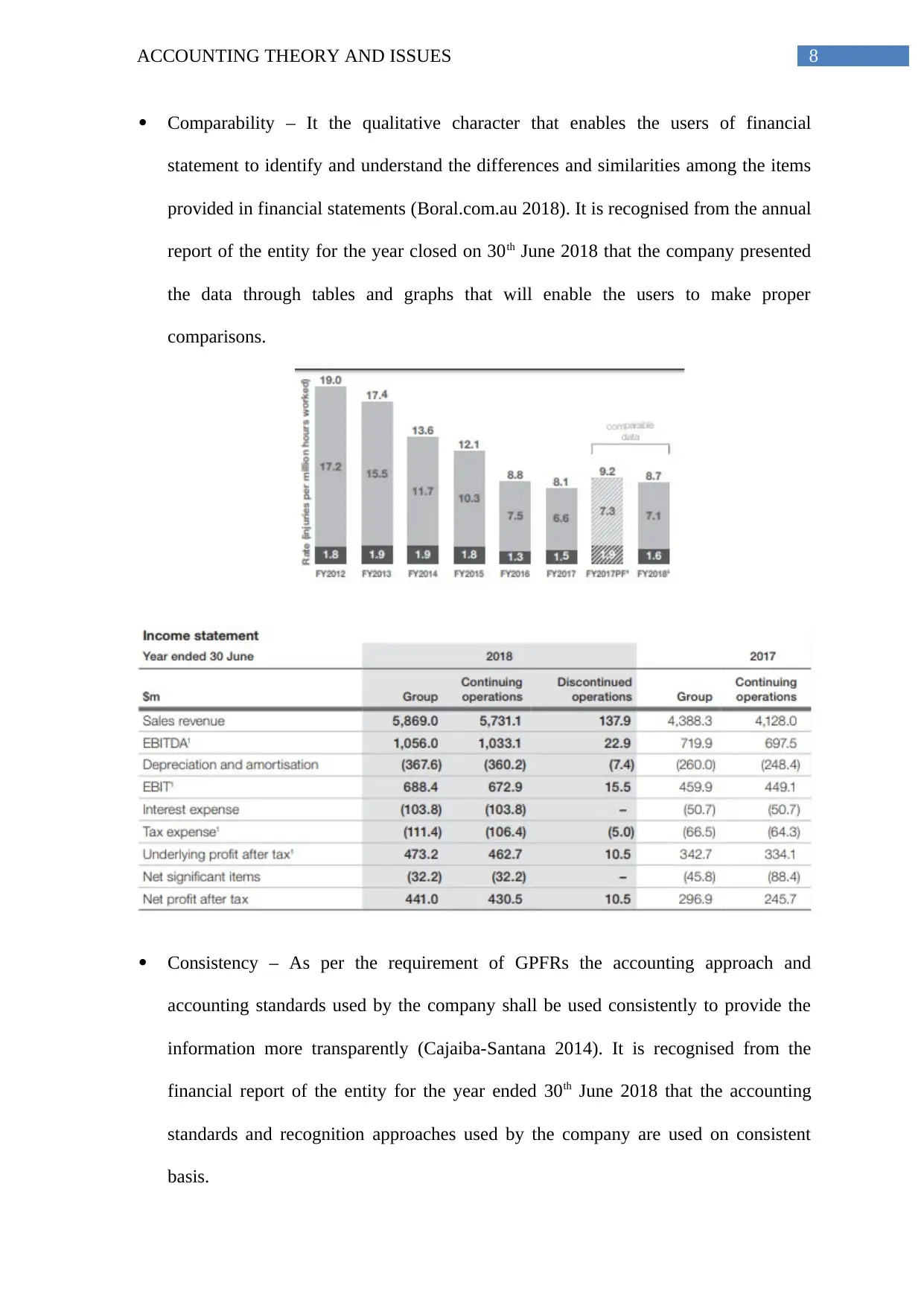
8ACCOUNTING THEORY AND ISSUES
Comparability – It the qualitative character that enables the users of financial
statement to identify and understand the differences and similarities among the items
provided in financial statements (Boral.com.au 2018). It is recognised from the annual
report of the entity for the year closed on 30th June 2018 that the company presented
the data through tables and graphs that will enable the users to make proper
comparisons.
Consistency – As per the requirement of GPFRs the accounting approach and
accounting standards used by the company shall be used consistently to provide the
information more transparently (Cajaiba-Santana 2014). It is recognised from the
financial report of the entity for the year ended 30th June 2018 that the accounting
standards and recognition approaches used by the company are used on consistent
basis.
Comparability – It the qualitative character that enables the users of financial
statement to identify and understand the differences and similarities among the items
provided in financial statements (Boral.com.au 2018). It is recognised from the annual
report of the entity for the year closed on 30th June 2018 that the company presented
the data through tables and graphs that will enable the users to make proper
comparisons.
Consistency – As per the requirement of GPFRs the accounting approach and
accounting standards used by the company shall be used consistently to provide the
information more transparently (Cajaiba-Santana 2014). It is recognised from the
financial report of the entity for the year ended 30th June 2018 that the accounting
standards and recognition approaches used by the company are used on consistent
basis.
⊘ This is a preview!⊘
Do you want full access?
Subscribe today to unlock all pages.

Trusted by 1+ million students worldwide
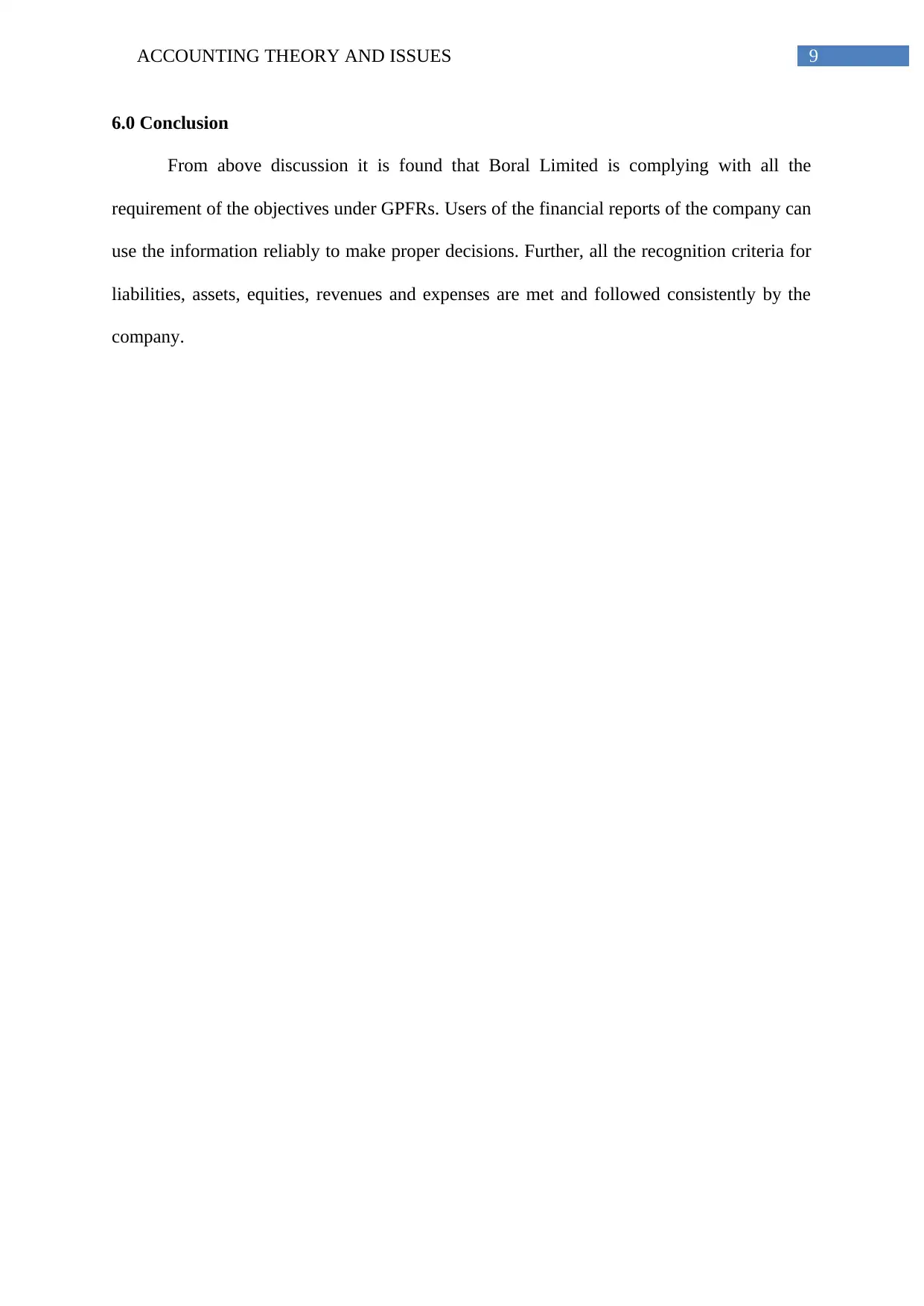
9ACCOUNTING THEORY AND ISSUES
6.0 Conclusion
From above discussion it is found that Boral Limited is complying with all the
requirement of the objectives under GPFRs. Users of the financial reports of the company can
use the information reliably to make proper decisions. Further, all the recognition criteria for
liabilities, assets, equities, revenues and expenses are met and followed consistently by the
company.
6.0 Conclusion
From above discussion it is found that Boral Limited is complying with all the
requirement of the objectives under GPFRs. Users of the financial reports of the company can
use the information reliably to make proper decisions. Further, all the recognition criteria for
liabilities, assets, equities, revenues and expenses are met and followed consistently by the
company.
Paraphrase This Document
Need a fresh take? Get an instant paraphrase of this document with our AI Paraphraser
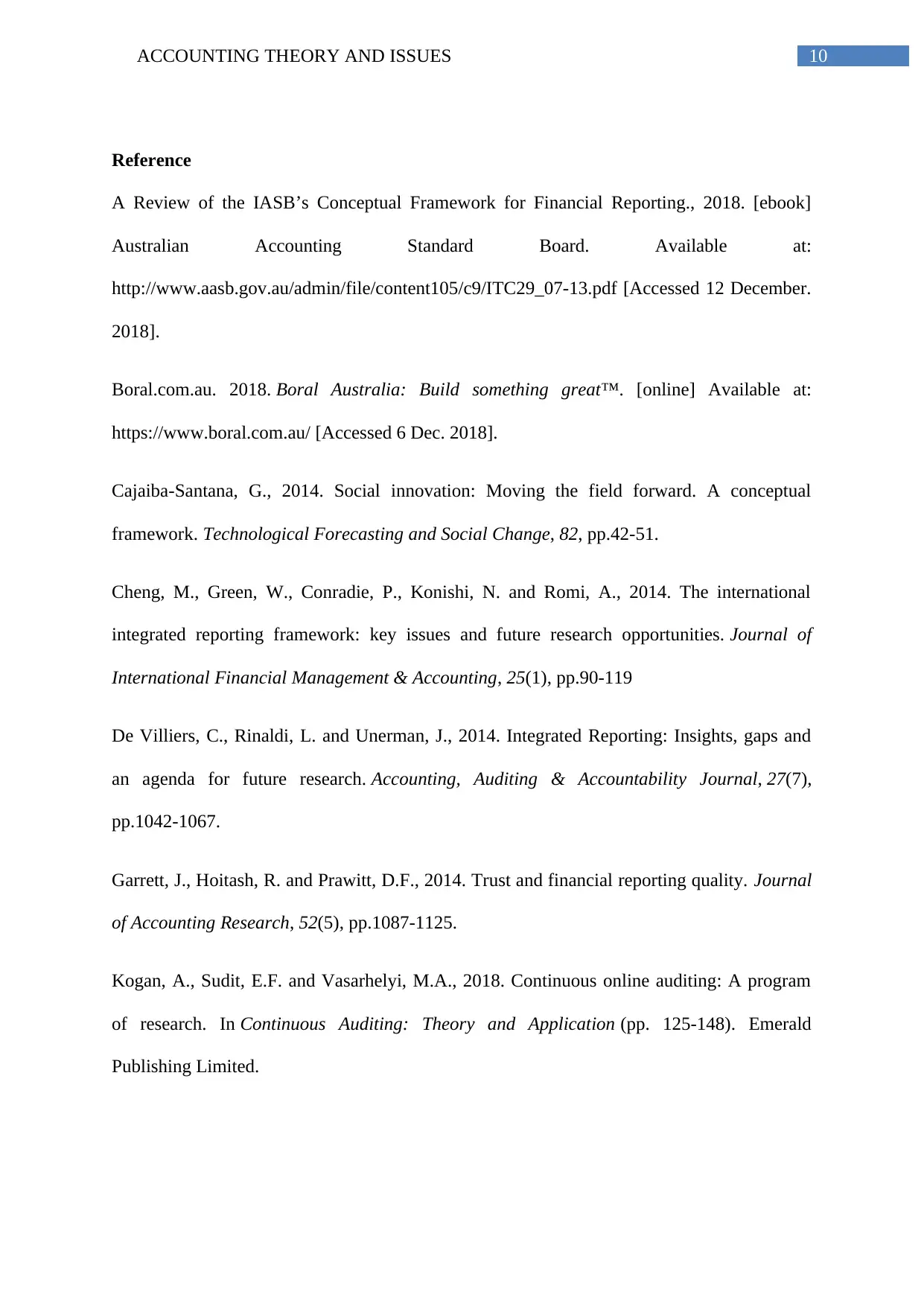
10ACCOUNTING THEORY AND ISSUES
Reference
A Review of the IASB’s Conceptual Framework for Financial Reporting., 2018. [ebook]
Australian Accounting Standard Board. Available at:
http://www.aasb.gov.au/admin/file/content105/c9/ITC29_07-13.pdf [Accessed 12 December.
2018].
Boral.com.au. 2018. Boral Australia: Build something great™. [online] Available at:
https://www.boral.com.au/ [Accessed 6 Dec. 2018].
Cajaiba-Santana, G., 2014. Social innovation: Moving the field forward. A conceptual
framework. Technological Forecasting and Social Change, 82, pp.42-51.
Cheng, M., Green, W., Conradie, P., Konishi, N. and Romi, A., 2014. The international
integrated reporting framework: key issues and future research opportunities. Journal of
International Financial Management & Accounting, 25(1), pp.90-119
De Villiers, C., Rinaldi, L. and Unerman, J., 2014. Integrated Reporting: Insights, gaps and
an agenda for future research. Accounting, Auditing & Accountability Journal, 27(7),
pp.1042-1067.
Garrett, J., Hoitash, R. and Prawitt, D.F., 2014. Trust and financial reporting quality. Journal
of Accounting Research, 52(5), pp.1087-1125.
Kogan, A., Sudit, E.F. and Vasarhelyi, M.A., 2018. Continuous online auditing: A program
of research. In Continuous Auditing: Theory and Application (pp. 125-148). Emerald
Publishing Limited.
Reference
A Review of the IASB’s Conceptual Framework for Financial Reporting., 2018. [ebook]
Australian Accounting Standard Board. Available at:
http://www.aasb.gov.au/admin/file/content105/c9/ITC29_07-13.pdf [Accessed 12 December.
2018].
Boral.com.au. 2018. Boral Australia: Build something great™. [online] Available at:
https://www.boral.com.au/ [Accessed 6 Dec. 2018].
Cajaiba-Santana, G., 2014. Social innovation: Moving the field forward. A conceptual
framework. Technological Forecasting and Social Change, 82, pp.42-51.
Cheng, M., Green, W., Conradie, P., Konishi, N. and Romi, A., 2014. The international
integrated reporting framework: key issues and future research opportunities. Journal of
International Financial Management & Accounting, 25(1), pp.90-119
De Villiers, C., Rinaldi, L. and Unerman, J., 2014. Integrated Reporting: Insights, gaps and
an agenda for future research. Accounting, Auditing & Accountability Journal, 27(7),
pp.1042-1067.
Garrett, J., Hoitash, R. and Prawitt, D.F., 2014. Trust and financial reporting quality. Journal
of Accounting Research, 52(5), pp.1087-1125.
Kogan, A., Sudit, E.F. and Vasarhelyi, M.A., 2018. Continuous online auditing: A program
of research. In Continuous Auditing: Theory and Application (pp. 125-148). Emerald
Publishing Limited.
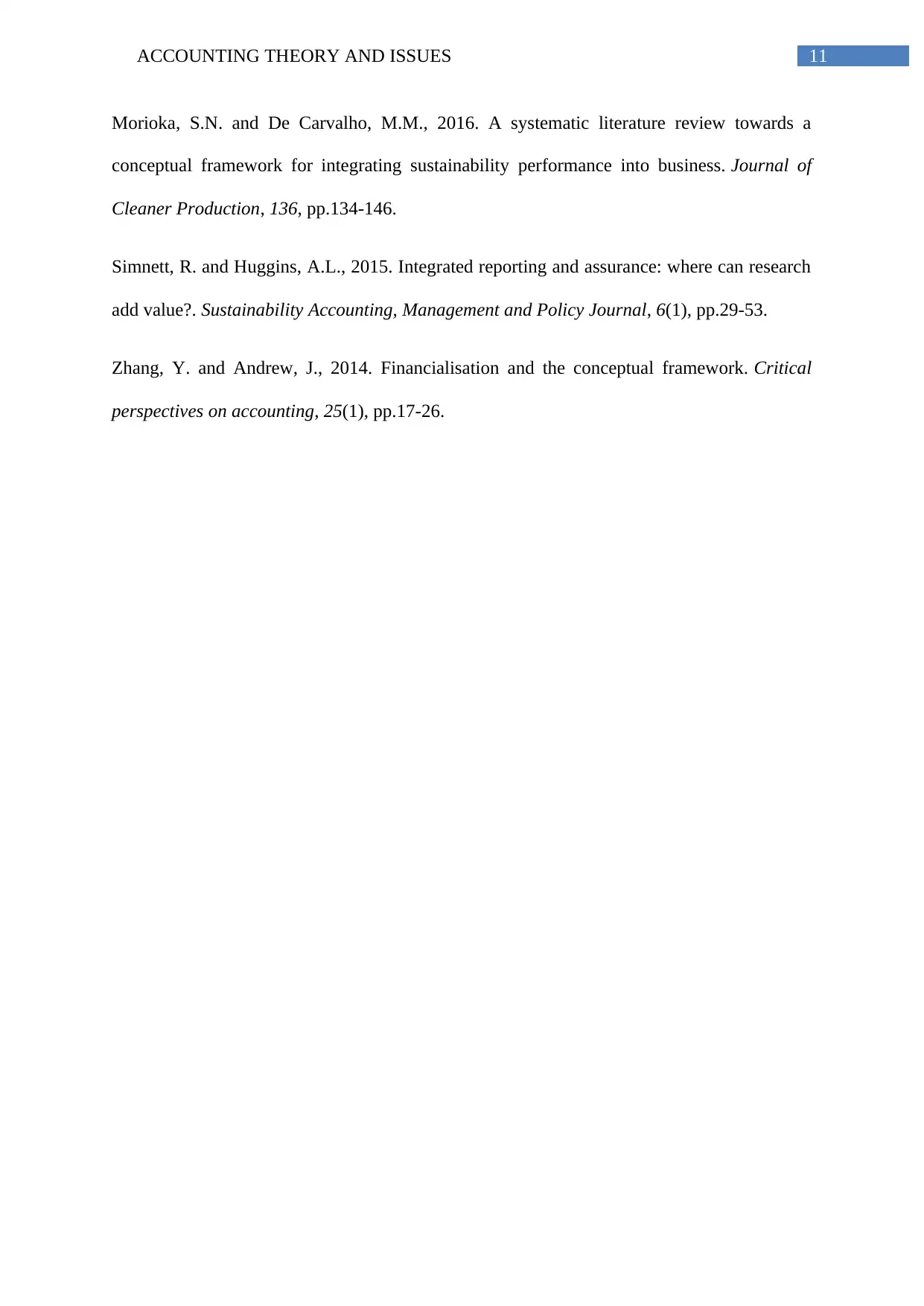
11ACCOUNTING THEORY AND ISSUES
Morioka, S.N. and De Carvalho, M.M., 2016. A systematic literature review towards a
conceptual framework for integrating sustainability performance into business. Journal of
Cleaner Production, 136, pp.134-146.
Simnett, R. and Huggins, A.L., 2015. Integrated reporting and assurance: where can research
add value?. Sustainability Accounting, Management and Policy Journal, 6(1), pp.29-53.
Zhang, Y. and Andrew, J., 2014. Financialisation and the conceptual framework. Critical
perspectives on accounting, 25(1), pp.17-26.
Morioka, S.N. and De Carvalho, M.M., 2016. A systematic literature review towards a
conceptual framework for integrating sustainability performance into business. Journal of
Cleaner Production, 136, pp.134-146.
Simnett, R. and Huggins, A.L., 2015. Integrated reporting and assurance: where can research
add value?. Sustainability Accounting, Management and Policy Journal, 6(1), pp.29-53.
Zhang, Y. and Andrew, J., 2014. Financialisation and the conceptual framework. Critical
perspectives on accounting, 25(1), pp.17-26.
⊘ This is a preview!⊘
Do you want full access?
Subscribe today to unlock all pages.

Trusted by 1+ million students worldwide
1 out of 12
Related Documents
Your All-in-One AI-Powered Toolkit for Academic Success.
+13062052269
info@desklib.com
Available 24*7 on WhatsApp / Email
![[object Object]](/_next/static/media/star-bottom.7253800d.svg)
Unlock your academic potential
Copyright © 2020–2025 A2Z Services. All Rights Reserved. Developed and managed by ZUCOL.





